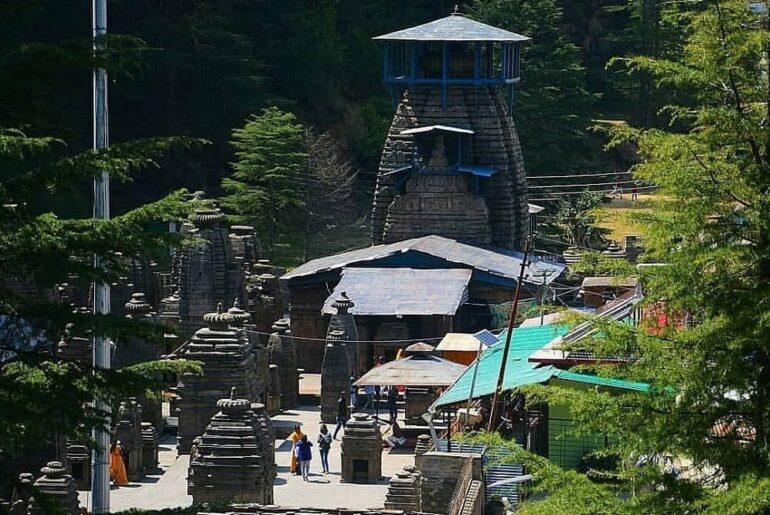Jageshwar Dham Temple: Exploring Uttarakhand’s Shiva Temples
Jageshwar Dham Temple lies in Uttarakhand’s serene Kumaon region. It is a famous pilgrimage destination surrounds by majestic Deodar forests and embraced by the Jataganga river. This divine site holds a deep spiritual and cultural significance, with its 124 ancient temples dedicated to Lord Shiva.
Legend of Temples
According to legend, God Shiva meditated here, infusing the area with divine energy. The divine Adi Guru Adi Shankaracharya also visited in the 8th century, further enhancing its importance.
The temple lies at an elevation of approximately 6200 feet above sea level. Jageshwar Dham temple built during the Katyuri dynasty and offers spiritual retreat amidst natural splendor for centuries. The temples are famous for their sturdy stone block construction adorned with depictions of Hindu deities on copper sheets and cedar wood door frames.
Jageshwar Dham
Jageshwar, known as the temple city, encompasses a cluster of 124 stone temples dating from the 9th to the 13th century AD. These temples, meticulously preserved by the Archaeological Survey of India (ASI), include notable structures such as the Dandeshwar Temple, Chandi-ka-Temple, Jageshwar Temple, Kuber Temple, Mrityunjaya Temple, Nanda Devi or Nau Durga Temple, Nava-grah Temple, a Pyramidal shrine, and Surya Temple.
Temple History
Jageshwar, described in ancient texts like Prasadmandanam as an abode of Lord Shiva. The temples, estimated by the Archaeological Survey of India (ASI) to be around 2500 years old. The temple span from the post-Gupta to pre-medieval eras, with construction ranging from the 8th to 18th centuries under the Katyuri and Chand dynasties. Renovated during King Shalivahandev’s rule, the temples received patronage from Katyuri and Chand Kings, who donated villages for their upkeep.
A visit of Adi Shankaracharya
Adi Shankaracharya visited Jageshwar, restoring and establishing temples before heading to Kedarnath. The Samsan Ghat served as the cremation ground for Chand Kings, possibly witnessing sati rituals. The temples are built in the Nagara style with tall spires crowned by Amalaka and Kalasha. They house stone lingams and sculptures of deities, embodying spiritual significance akin to the Chardham yatra.
Suggested Read: Shiva Temples in the Himalayas of Uttarakhand: These 15 temples you can’t miss

On the way to Kailash and Mansarovar
Before roads, pilgrims passed through Jageshwar en route to Kailash and Mansarovar. Although restrictions altered the route to Kedarnath, Jageshwar has regained prominence. The main temple, ‘Jageshwar Mahadev’, venerates ‘Bal Jageshwar’ (Child Shiva), while ‘Vridh Jageshwar’ (Old Shiva) sits higher. Legend holds that Shiva transformed into a child to evade villagers’ curiosity when they interrupted his meditation, thus continuing to be worshipped in this form.
Location
It lies by the Jataganga river valley near a Deodar forest starting from Artola village on the Almora–Pithoragarh highway, Jageshwar is where two streams, Nandini and Surabhi, flow down the hills and converge near this sacred spot. It was once the center of Lakulish Shaivism, a significant sect of Shaivism
How to Reach Jageshwar Dham Temple
- Jageshwar Dham Temple can be reached via the nearest railway station at Kathgodam.
- Bus services are available from Delhi’s Anand Vihar ISBT and Dehradun to Haldwani and Almora, both approximately 400 km away.
- From Almora, a 35 km road trip by taxi leads to Jageshwar Dham.
- The nearest airport, Pantnagar Airport, from Airport is a 150 km taxi ride to reach the temple.
Festivals and Celebrations:
Jageshwar is home of god Nagesh among Deodar forests and is recognized as the 8th of the Dwadasa Jyotirlingas—12 sacred lingas of Lord Shiva established by Lord Vishnu. The town hosts the Jageshwar Monsoon Festival from 15 July to 15 August during the Hindu month of Shravan, and the annual Maha Shivratri Mela in spring, which is a significant event in the Kumaon region’s
Nearby Attractions:
Explore nearby attractions including:
- Kausani: Known for stunning Himalayan sunrise and sunset views.
- Binsar Wildlife Sanctuary: Home to diverse flora and fauna, with trekking trails offering panoramic views.
- Jatashankar Cave: A mystical site associated with Lord Shiva, known for its unique rock formations.
- Chitai Golu Devta Temple: Experience local traditions at this ancient temple known for miniature bell offerings.
- Kasar Devi Temple: Admire panoramic Himalayan views and soak in spiritual tranquility.
Book Your Ritual
Pilgrims can book ceremony ritual within the temple complex ‘s booking office. At the office counter, pilgrims can arrange for various rituals like Puja by paying the applicable fees. Additionally, they have the opportunity to purchase books and publications that delve into the rich history and traditions of Jageshwar Dham temple.
Conclusion
Jageshwar Dham in Uttarakhand is not just a pilgrimage site but a sanctuary where spirituality meets natural beauty. Amidst the serene Deodar forests and the soothing sounds of Jata Ganga river, visitors find solace and a deep connection to ancient traditions and devotion.




Comments are closed.